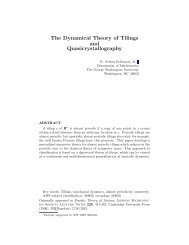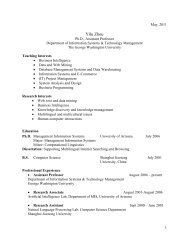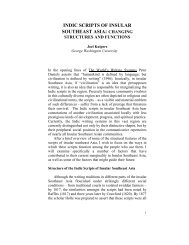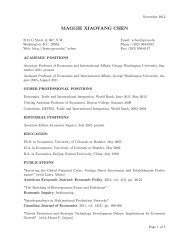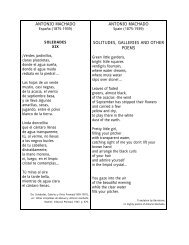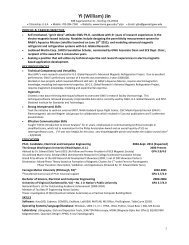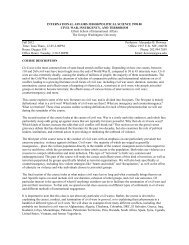Bribery as a Signal of Employee Skill Bogdan Bonca ... - gwu.edu
Bribery as a Signal of Employee Skill Bogdan Bonca ... - gwu.edu
Bribery as a Signal of Employee Skill Bogdan Bonca ... - gwu.edu
Create successful ePaper yourself
Turn your PDF publications into a flip-book with our unique Google optimized e-Paper software.
<strong>Bribery</strong> <strong>as</strong> a <strong>Signal</strong> <strong>of</strong> <strong>Employee</strong> <strong>Skill</strong><br />
<strong>Bogdan</strong> <strong>Bonca</strong> (GWU), Artur Kol<strong>as</strong>a (GWU)<br />
The paper looks at the process <strong>of</strong> bribing in the hiring process. While the practice<br />
is not widespread in the developed world, in developing countries bribing to obtain a job<br />
is rather common, especially for public sector jobs. We analyze the incidence <strong>of</strong> bribes<br />
and <strong>as</strong>k whether the size <strong>of</strong> bribes <strong>of</strong>fered can be treated <strong>as</strong> a signal for the future<br />
employees skill level. The intuition behind our analysis is that a highly skilled employee<br />
would have higher chances <strong>of</strong> getting alternative jobs, thus r<strong>edu</strong>cing the <strong>of</strong>fer <strong>of</strong> a bribe.<br />
We analyze the problem by developing a theoretical model and testing some <strong>of</strong><br />
the predictions <strong>of</strong> the theoretical model empirically. On the theoretical side, we develop a<br />
utility maximization equation for a risk-neutral agent on the employer side and a similar<br />
equation on the agent side. We allow for uncertainty <strong>of</strong> alternatives and correlate them<br />
positively with skill. The results <strong>of</strong> the theoretical model suggest that higher skilled<br />
works would <strong>of</strong>fer lower bribes for a job than lower skilled workers. Additionally, we<br />
find that, under certain conditions, hiring managers would find it beneficial to accept the<br />
lower bribe <strong>of</strong> a higher skilled worker when faced with a dynamic optimization problem.<br />
To test some <strong>of</strong> the results from the theoretical model, we use the World<br />
Enterprise Survey data set, focusing on Bangladesh. As the survey lacks data on bribes<br />
pain in the hiring process, we proxy that by the percentage <strong>of</strong> firm’s sales that the given<br />
firm pays in bribes. The logic behind the proxy is that we expect to observe a strong<br />
positive correlation between a firm’s propensity to pay bribes and its propensity to accept<br />
them. Using an ordered logit estimation, the dependent variable is “the average<br />
<strong>edu</strong>cational attainment <strong>of</strong> a typical production employee” in a given firm. This is an<br />
ordinal variable with the following cut<strong>of</strong>fs:<br />
1: no formal <strong>edu</strong>cation (0-3 years <strong>edu</strong>cation)<br />
2: primary <strong>edu</strong>cation (4-6 years <strong>edu</strong>cation)<br />
3: secondary <strong>edu</strong>cation (7-12 years <strong>edu</strong>cation)<br />
4: university degree (13+ years <strong>edu</strong>cation)<br />
Our treatment variable is the proportion <strong>of</strong> annual sales paid in bribes. We control for<br />
l<strong>as</strong>t year’s wages paid per firm, firm sales, firm size and the percentage <strong>of</strong> full time<br />
employees that are <strong>of</strong>fered training, and how many years <strong>of</strong> experience does the manager<br />
have. 1 Since we use an ordered logit estimation, fixed effects can’t be applied. In order<br />
to alleviate this issue, we cluster errors around industry identification variable (me<strong>as</strong>ured<br />
at sitc 2 level).<br />
The results from the empirical model reinforce the predictions <strong>of</strong> the theoretical mode.<br />
Namely, the empirical model proves that there is a significant correlation between bribery<br />
and the skill <strong>of</strong> the workers. Also, with 99% confidence, the model estimates that such<br />
relationship is positive (suggesting that higher bribes can be attributed to higher skill<br />
levels).<br />
1 Size: 1: firm h<strong>as</strong> between 5 and 49 workers, 2: firm h<strong>as</strong> between 50 and 99 workers, 3: firm h<strong>as</strong> over 100<br />
workers.
Appendix<br />
The following are preliminary results <strong>of</strong> an ordered logit with average <strong>edu</strong>cational<br />
attainment <strong>of</strong> production employee <strong>as</strong> the dependent:<br />
(1)<br />
percentage <strong>of</strong> sales paid <strong>as</strong> bribes 0.0466***<br />
(0.0159)<br />
ln_sales 0.176*<br />
(0.0933)<br />
size -0.151<br />
(0.194)<br />
manager experience -0.0177<br />
(0.0130)<br />
percentage <strong>of</strong> full time employees trained 0.00767*<br />
(0.00428)<br />
ln_wages_l<strong>as</strong>t_year -0.0163<br />
(0.121)<br />
N 350




